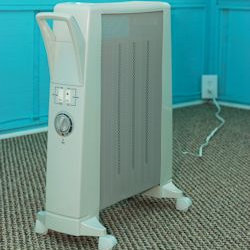Portable Heaters
OSHA provides numerous requirements and guidelines under various standards, including the General Duty Clause Section 5(a)(1) of the OSHAct, which requires employers to maintain a workplace free from recognized hazards.

Below is a summary of General Industry (29 CFR 1910) and Construction (29 CFR 1926) OSHA rules and guidelines relevant to fire protection and prevention. You can access these rules through our Resources Page.
Use According to Manufacturer Specifications
- Portable electric space heaters must be used in accordance with the manufacturer’s specifications as indicated on the unit’s label and in the user manual. This ensures the equipment operates within its designed safety parameters.
Ventilation Requirements
- When space heaters are used in confined spaces, sufficient ventilation must be provided to ensure proper combustion, maintain worker health and safety, and limit temperature rises. This is critical for fuel-fired heaters to prevent hazards like carbon monoxide poisoning.
Clearance from Combustible Materials
- Circulating heaters: At least 12 inches from sides and rear, and 18 inches from the chimney connector.
- Radiant heaters: At least 36 inches from sides and rear, and 18 inches from the chimney connector.
- Heaters listed for lesser clearances may be installed per their approval.
- Heaters used near combustible tarpaulins, canvas, or similar coverings must be located at least 10 feet away, and coverings must be securely fastened to prevent ignition or heater upset due to wind.
Mounting and Stability
- Heaters not suitable for use on wood floors or other combustible surfaces must rest on heat-insulating material or at least 1-inch concrete (or equivalent), extending 2 feet or more beyond the heater in all directions.
- Heaters must be set horizontally level unless otherwise permitted by the manufacturer’s markings to ensure stability and prevent tipping.
Prohibited Heater Types
- Solid fuel salamanders are prohibited in buildings and on scaffolds due to their high fire risk.
Fuel-Fired Heater Safety Controls
- Flammable liquid-fired heaters must have a primary safety control to stop fuel flow in case of flame failure.
- Barometric or gravity oil feed systems are not considered primary safety controls.
- Heaters designed for barometric or gravity oil feed must use integral tanks unless specifically approved for separate supply tanks with gravity feed or automatic pumps.
- Portable heaters using liquefied petroleum gas (LP-Gas) with inputs above 50,000 Btu per hour must have an approved automatic device to shut off gas flow in the event of flame failure.
Electrical Safety
- Portable electric space heaters and their cords must be visually inspected before each shift for external defects (e.g., loose parts, damaged insulation) or internal damage (e.g., pinched cords).
- Extension cords, if used, must be rated to handle the electrical load of the heater. However, many employers prohibit extension cords with space heaters due to overheating risks, recommending direct connection to a wall outlet.
- Heaters must not be used in wet or highly conductive environments unless approved for such conditions.
Fire Protection Requirements
- For temporary heating with LP-Gas, heaters (other than integral heater-container units) must be located at least 6 feet from LP-Gas containers to prevent ignition risks.
- At least one portable fire extinguisher with a minimum rating of 20-B:C must be readily available when LP-Gas heaters are used.
- A fire extinguisher with a minimum rating of 4A:40-B:C must be available when temporary heating devices are in use.
Prohibited Uses and Additional Guidelines
- Space heaters must have safety features like tip-over sensing shutoff switches and thermostatic controls to prevent overheating or fires.
- Heaters must be approved by a Nationally Recognized Testing Laboratory (NRTL), such as Underwriters Laboratories (UL), Canadian Standards Association (CSA), or Intertek (ETL).
- Heaters should not be placed in high-traffic areas or where they pose tripping hazards, such as doorways.
- Unvented combustion heaters (e.g., propane, natural gas, kerosene) are not recommended for indoor use due to risks of carbon monoxide and other combustion byproducts. Local regulations may ban these heaters.
Employer Responsibilities
- Employers should establish a written policy for space heater use, specifying approved devices, safety features, and precautions.
- Supervisor or management approval is recommended before using space heaters.
- Heaters must be turned off and unplugged when unattended or at the end of the workday to reduce fire risks.
Knowledge Check Choose the best answer for the question.
2-2. What safety feature should be included in portable heaters in the workplace?
You forgot to answer the question!
